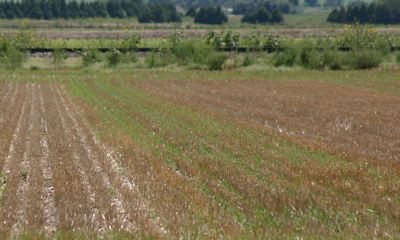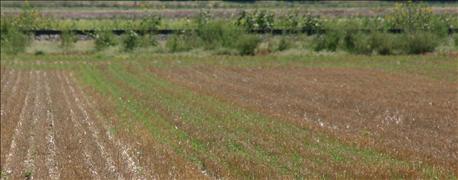August 20, 2015

Many Nebraska wheat farmers are still talking about the highly unusual weather that caused problems for the 2015 winter wheat crop.
But now, between harvest and planting, growers can take several steps to help the 2016 crop get off to the best start possible. In the process, they will be good neighbors to fellow producers.
Despite abundant moisture, wheat yields across the Panhandle suffered, due to a combination of factors, most of which are related to weather.

POTENTIAL 2016 PROBLEMS: Volunteer wheat emerging in wheat stubble. Hailed out wheat becomes green volunteer wheat that can host numerous potential problems.
Several weather patterns affected the crop that's now in the bin. Winter temperature fluctuations caused wheat to winter kill causing poor stands. Relentless spring rains and cool temperatures delayed spraying and created an ideal environment for leaf and stripe rust to thrive. The May snowstorm when most wheat was in the boot stage or heading out caused freeze damage.
Many growers are lamenting low wheat yields or wondering what yields might have been. Hailstorms across parts of the Panhandle destroyed any wheat in their path. Two notable storms passed through Banner County and near Hemingford.
Not only were growers in these areas not able to harvest wheat this year, they are now at risk for problems next year. Hailed out wheat quickly becomes green volunteer wheat that can host numerous potential problems, including mites which transmit diseases like wheat streak mosaic virus (WSMV) and high plains virus.
Of these, the most worrisome is WSMV because of its ability to completely decimate a wheat field.
Symptoms of WSMV are visible on the youngest wheat leaves showing a yellow mosaic pattern of parallel discontinuous streaks. Over time, this will change to become mottled yellow and similar in some ways to barley yellow dwarf virus symptoms.
Typically after wheat harvest, wheat curl mite activity decreases significantly because of the lack of a suitable host plant. However, volunteer wheat, especially wheat that emerges prior to wheat harvest due to a hail event, can provide the mites a suitable habitat to survive until winter wheat is planted in the fall. This is known as a "green bridge."
Other crops and summer annual weeds can serve as a green bridge. Suitable crops include corn, oats, sorghum, and millet, among others. Suitable weeds include goatgrass, cheatgrass, foxtails, barnyardgrass, and stinkgrass, among others. The greater the density of the grass weeds, the greater the risk.
~~~PAGE_BREAK_HERE~~~
In addition to serving as hosts to mites, volunteer wheat and weeds use valuable soil moisture that could otherwise be used to grow next years' crop. Weeds left uncontrolled will also produce seeds that create future problems.
The most effective way to protect against WSMV is to destroy the green bridge, using tillage or herbicides. This will likely require two applications. The first will control the initial flush of volunteer wheat and weeds. The second should be completed two weeks prior to planting winter wheat.
Other prevention methods need to be used when the mite source includes a crop. Ideally, the crop would be harvested early enough to allow for control methods to be used to remove any remaining potential hosts two weeks prior to planting winter wheat. In many instances, crops like corn, for example, will not fully mature and be harvested until after wheat planting.
There are two methods to manage WSMV when planting winter wheat in high-risk situations. First, avoid planting early and plant high-risk fields last. Second, plant tolerant varieties either in the entire field or in a strip near the likely source or mite infestation. Mace is a variety that is resistant to WSMV. There are a number of other varieties that are moderately resistant.
Mites travel using the wind, but usually will not travel too far. For this reason, initial infestations usually occur around field margins near the mite source and move with the prevailing wind. Understanding this will help to develop a plan to mitigate risk.
Be thoughtful and communicate your plans with your neighbors. Know where your neighbors anticipate planting winter wheat and control potential mite hosts nearby, especially if you suffered a hail storm. Control volunteer wheat and remove hailed out corn quickly to prevent a possible green bridge. If corn is slow to mature in the fall, use caution when choosing to plant winter wheat nearby. Prevent and plan now to have a successful wheat crop next year.
For more information, contact Cody Creech, Dryland Cropping Systems Specialist at the University of Nebraska-Lincoln Panhandle Research and Extension Centerat [email protected].
Source: UNL Panhandle Research and Extension Center
You May Also Like




